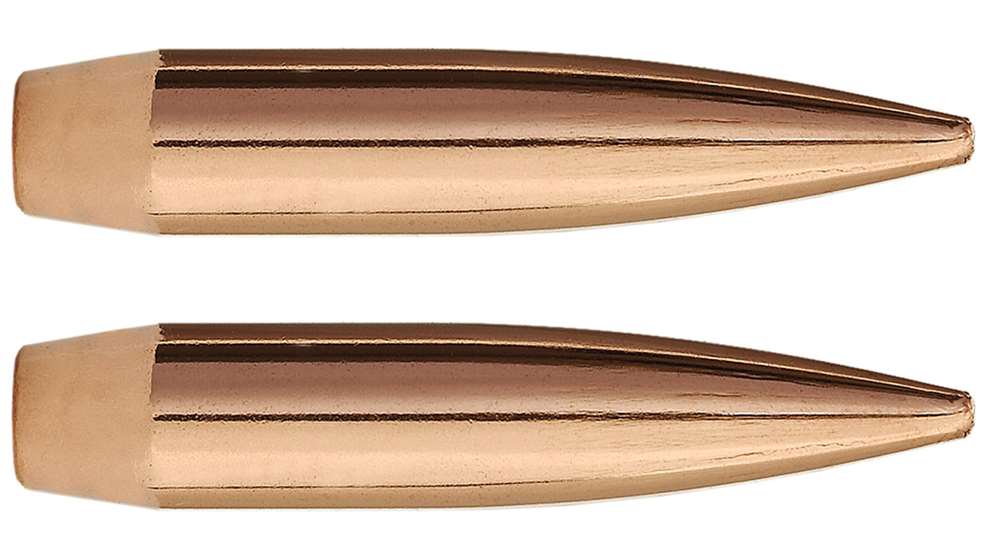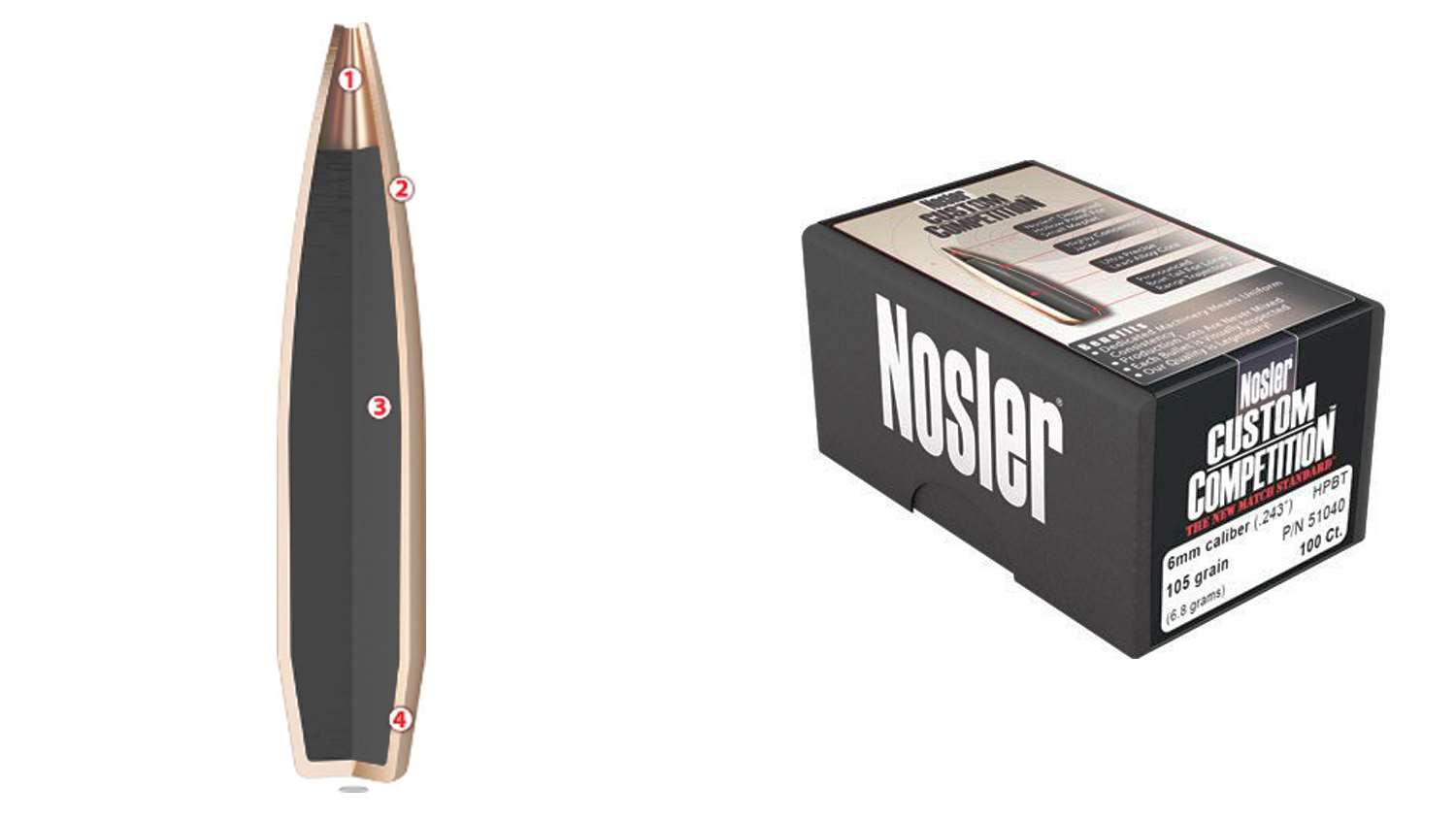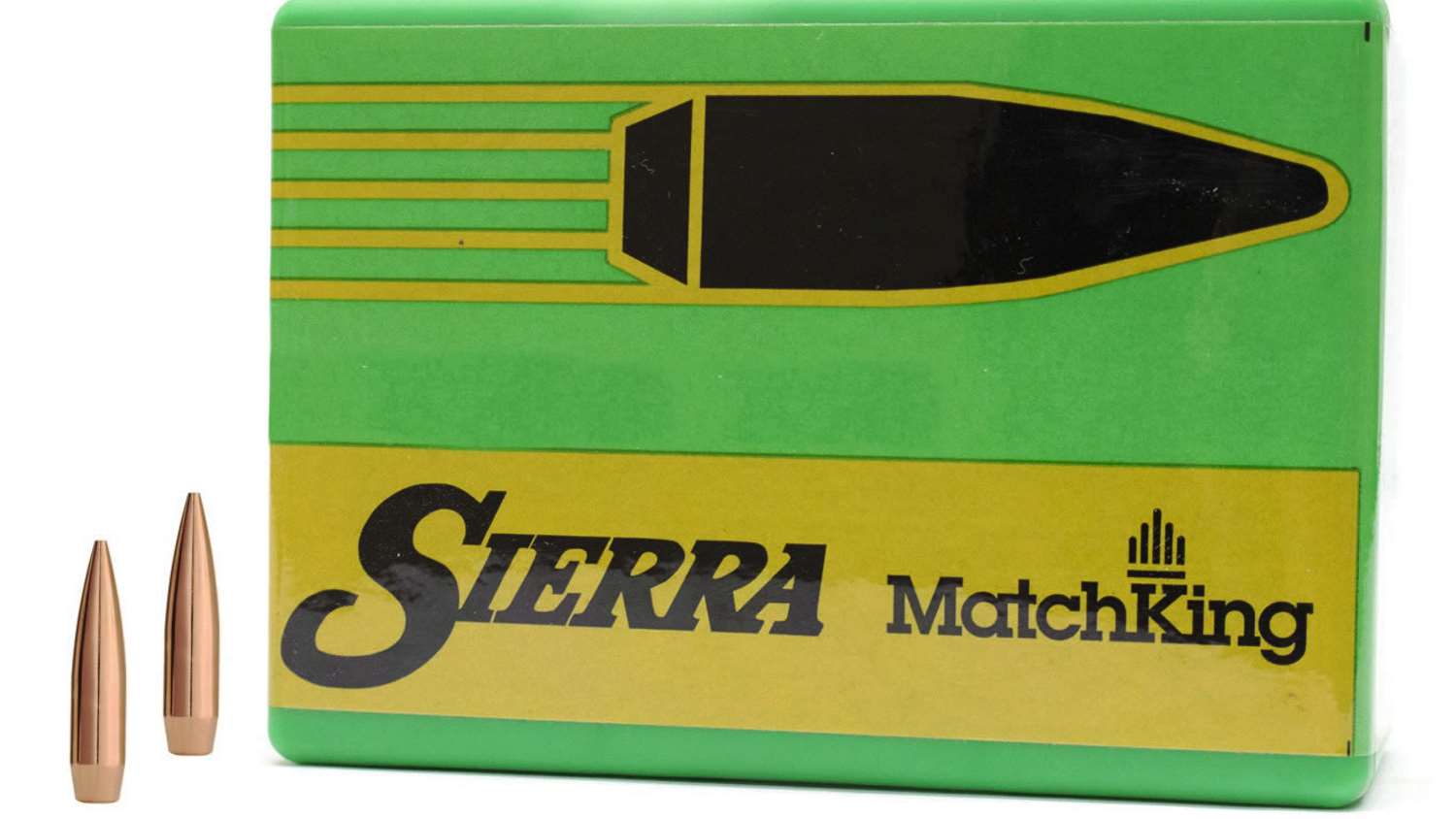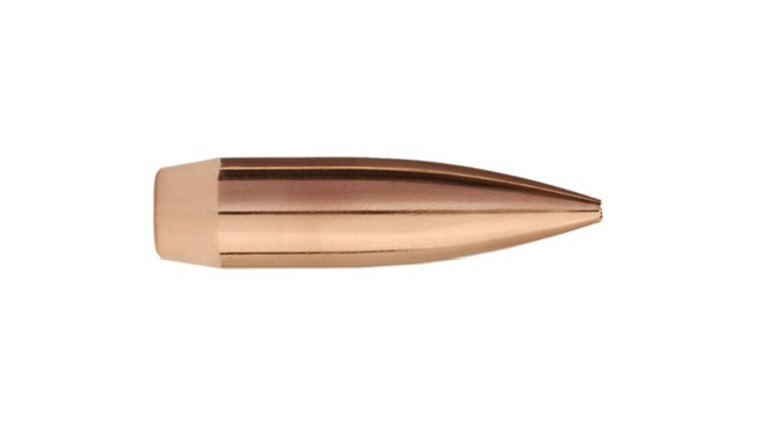** When you buy products through the links on our site, we may earn a commission that supports NRA's mission to protect, preserve and defend the Second Amendment. **

From 1920 until the mid-1950s, full metal jacket (FMJ) bullets remained the epitome for high power competition. Handloading was not common, so competitors relied on government arsenals for match-grade, .30-06 Spr. ammunition for use in the National Matches and other shooting events. Arsenal match ammunition was considered state-of-the-art and was perpetually in short supply. Ammunition lots performing particularly well were carefully hoarded, traded and fired judiciously. Naturally, government arsenals made what they knew best and had tooling for—FMJ bullets.
By the mid-1950s, improved match rifles were better than arsenal ammunition. This dilemma spurred improvements in ammunition and led many competitors into handloading. Sierra Bullets began offering match-grade, hollow-point boattail rifle bullets which offered significantly improved accuracy over FMJ bullets. As records tumbled, hollow-point boattail bullets increasingly ruled high power competition.

Now, decades later, high power competitors rely on hollow-point boattail match bullets for serious competition. Civilian shooters had no choice but to handload such bullets until the mid-1970s. At that time, ammunition manufacturers began offering factory-loaded, match-grade rifle ammunition in selected calibers with hollow-point boattail bullets. U.S. military shooting teams also found it necessary to handload hollow points to remain competitive. In the early 1980s, increased military demand for match ammunition loaded with hollow-point boattail bullets led the U.S. Army to adopt the 7.62mm M852 match cartridge made at Lake City Army Ammunition Plant using bullets purchased from qualified, outside sources.
The "Perfect" Match Bullet
From the standpoint of interior ballistics, the ideal match rifle bullet would be a bore-diameter, homogeneous cylinder with flat ends perfectly square to its body. Such a bullet would be cheap, easy to manufacture and have maximum bearing surface for superior accuracy.
From the standpoint of exterior ballistics, an efficient match rifle bullet would have a high length-to-diameter ration; a sharp, drag-reducing point; and a tapered base (boattail). Such a bullet would offer high retained velocity, flat trajectory and minimum wind drift.
From the standpoint of terminal ballistics, the ideal match rifle bullet would offer a center of gravity displaced toward the base, a jacket with no sidewall variations and a core with no weight variation. Such a bullet would offer consistent, reliable, sub-minute-of-angle (MOA) accuracy from lot to lot.
These requirements pull match rifle bullet designers in different, often mutually exclusive, directions. As a result, all match rifle bullets are a compromise—none are perfect.
Labor for Accuracy
When a bullet jacket is drawn, some variation in sidewall thickness has to be tolerated, but the amount must be kept minimal. Most military FMJ bullets and expanding hunting bullets have average sidewall runouts of .0008-inch. Match-grade rifle bullet jackets must average less than half that, as bullets with minimal sidewall variations are more concentric and therefore more accurate.
Many match bullet manufacturers prefer continuously annealed, virgin, 95/5 copper alloy (95 percent copper and 5 percent zinc) material for jackets, as it offers excellent draw characteristics and superior tolerance control. In contrast, many FMJ and hunting bullets are made with reprocessed, 90/10 copper alloy jackets or even plated-on jackets.
However, a high quality jacket is not enough. Minimal jacket sidewall variation must be maintained as the bullet is manufactured. Some bullet designs accommodate this while others do not. For example, as the jacket's flat base is formed into a point to make an FMJ bullet, displaced jacket material creates sidewall variations regardless of how true the jacket was to start with. On the other hand, the ogive of a hollow-point bullet is formed on air and the jacket sidewalls left undisturbed.
For consistent accuracy, a bullet's base must be square to the body. Bases which are not square induce excessive yaw at the muzzle as the bullet uncorks unevenly. Holding bullet squareness in a bullet formed on the heel is much easier than one formed on the tip. Hollow-point bullet cores are inserted from the front and the point formed using the flat heel of the bullet as a base. With this method, holding base squareness is easy. Cores for FMJ bullets are inserted from the rear and the bullet formed on the tapering bullet ogive. This makes it difficult to hold base squareness consistently.
Weight variations are easier to hold in hollow-point bullets as the soft lead core easily fills the jacket and the front face of the core under the hollow point remains flat. In an FMJ bullet, weight variations resulting from seating the hard lead core in the tapering jacket are much harder to control and create variations in base configuration. Hollow-point match bullets often vary less than ½-grain in total weight, while FMJ bullets can vary by twice that and more.
About the Shape of Things
Many shooters feel the sharp point on an FMJ bullet will slice through the air better than a hollow point bullet which has a small flat (or meplat) across the tip. While the sharp point of the FMJ bullet is slightly more efficient than the hollow point design, the difference is minimal. This is because tip drag on a pointed bullet accounts for less than five percent of total drag. In real terms therefore, the sharp tip of the FMJ is barely a percent or two more efficient than the hollow point.

Most rifle bullets have a tangent (sharp) ogive or a secant (sharper) ogive. While the sharper point of the secant ogive may have appeal, the tangent point maximizes bearing surface, critical to accuracy. For this reason, most hollow point match bullets have tangent ogive points.
Hollow-point match rifle bullets have a very small opening in the nose. This minimal opening is designed to maintain a minimal meplat. It is not designed for expansion. In fact, most hollow-point match rifle bullets will not expand on impact unless the target is at extremely close range and even then, expansion may be erratic. (For those reasons, match bullets should never be used for hunting.)
The streamlined, tapered base of the boattail bullet significantly reduces base drag that translates directly into higher retained velocity, flatter trajectory and less wind drift. These are vitally important advantages for competitors at all ranges. However, one size does not fit all and a tapered base eats up bearing surface, so boattails come in different lengths and taper angles tailoring each to bullet caliber, length, weight and average muzzle velocity.
Note that match rifle bullets do not have a cannelure. This is intentional as a cannelure distorts the jacket sidewalls, upsetting concentricity. The purpose of a cannelure is to help control bullet seating depth by giving the crimp a place to grab the bullet securely. As match rifle bullets are never crimped, the cannelure is not necessary.
Summary
Hollow point boattail rifle match bullets will continue to dominate high power competition because they comprise the best combination of features, performance and consistency for the price.
Lead image courtesy of Sierra Bullets. It is the .243 Cal. 107-grain Hollow-Point Boattail MatchKing bullet
By the mid-1950s, improved match rifles were better than arsenal ammunition. This dilemma spurred improvements in ammunition and led many competitors into handloading. Sierra Bullets began offering match-grade, hollow-point boattail rifle bullets which offered significantly improved accuracy over FMJ bullets. As records tumbled, hollow-point boattail bullets increasingly ruled high power competition.

Nosler Custom Competition hollow-point rifle bullets include: 1) a hollow point that provides small meplat for increased aerodynamic efficiency, 2) a quality jacket, 3) lead-alloy core for stability, and 4) boattail design for optimum flight characteristics at multiple velocities
Now, decades later, high power competitors rely on hollow-point boattail match bullets for serious competition. Civilian shooters had no choice but to handload such bullets until the mid-1970s. At that time, ammunition manufacturers began offering factory-loaded, match-grade rifle ammunition in selected calibers with hollow-point boattail bullets. U.S. military shooting teams also found it necessary to handload hollow points to remain competitive. In the early 1980s, increased military demand for match ammunition loaded with hollow-point boattail bullets led the U.S. Army to adopt the 7.62mm M852 match cartridge made at Lake City Army Ammunition Plant using bullets purchased from qualified, outside sources.
The "Perfect" Match Bullet
From the standpoint of interior ballistics, the ideal match rifle bullet would be a bore-diameter, homogeneous cylinder with flat ends perfectly square to its body. Such a bullet would be cheap, easy to manufacture and have maximum bearing surface for superior accuracy.
From the standpoint of exterior ballistics, an efficient match rifle bullet would have a high length-to-diameter ration; a sharp, drag-reducing point; and a tapered base (boattail). Such a bullet would offer high retained velocity, flat trajectory and minimum wind drift.
From the standpoint of terminal ballistics, the ideal match rifle bullet would offer a center of gravity displaced toward the base, a jacket with no sidewall variations and a core with no weight variation. Such a bullet would offer consistent, reliable, sub-minute-of-angle (MOA) accuracy from lot to lot.
These requirements pull match rifle bullet designers in different, often mutually exclusive, directions. As a result, all match rifle bullets are a compromise—none are perfect.
Labor for Accuracy
When a bullet jacket is drawn, some variation in sidewall thickness has to be tolerated, but the amount must be kept minimal. Most military FMJ bullets and expanding hunting bullets have average sidewall runouts of .0008-inch. Match-grade rifle bullet jackets must average less than half that, as bullets with minimal sidewall variations are more concentric and therefore more accurate.
Many match bullet manufacturers prefer continuously annealed, virgin, 95/5 copper alloy (95 percent copper and 5 percent zinc) material for jackets, as it offers excellent draw characteristics and superior tolerance control. In contrast, many FMJ and hunting bullets are made with reprocessed, 90/10 copper alloy jackets or even plated-on jackets.
However, a high quality jacket is not enough. Minimal jacket sidewall variation must be maintained as the bullet is manufactured. Some bullet designs accommodate this while others do not. For example, as the jacket's flat base is formed into a point to make an FMJ bullet, displaced jacket material creates sidewall variations regardless of how true the jacket was to start with. On the other hand, the ogive of a hollow-point bullet is formed on air and the jacket sidewalls left undisturbed.
For consistent accuracy, a bullet's base must be square to the body. Bases which are not square induce excessive yaw at the muzzle as the bullet uncorks unevenly. Holding bullet squareness in a bullet formed on the heel is much easier than one formed on the tip. Hollow-point bullet cores are inserted from the front and the point formed using the flat heel of the bullet as a base. With this method, holding base squareness is easy. Cores for FMJ bullets are inserted from the rear and the bullet formed on the tapering bullet ogive. This makes it difficult to hold base squareness consistently.
Weight variations are easier to hold in hollow-point bullets as the soft lead core easily fills the jacket and the front face of the core under the hollow point remains flat. In an FMJ bullet, weight variations resulting from seating the hard lead core in the tapering jacket are much harder to control and create variations in base configuration. Hollow-point match bullets often vary less than ½-grain in total weight, while FMJ bullets can vary by twice that and more.
About the Shape of Things
Many shooters feel the sharp point on an FMJ bullet will slice through the air better than a hollow point bullet which has a small flat (or meplat) across the tip. While the sharp point of the FMJ bullet is slightly more efficient than the hollow point design, the difference is minimal. This is because tip drag on a pointed bullet accounts for less than five percent of total drag. In real terms therefore, the sharp tip of the FMJ is barely a percent or two more efficient than the hollow point.

Many bullet manufacturers, including Sierra Bullets, have found it easier to build concentric, balanced hollow-point boattail bullets than FMJs
Most rifle bullets have a tangent (sharp) ogive or a secant (sharper) ogive. While the sharper point of the secant ogive may have appeal, the tangent point maximizes bearing surface, critical to accuracy. For this reason, most hollow point match bullets have tangent ogive points.
Hollow-point match rifle bullets have a very small opening in the nose. This minimal opening is designed to maintain a minimal meplat. It is not designed for expansion. In fact, most hollow-point match rifle bullets will not expand on impact unless the target is at extremely close range and even then, expansion may be erratic. (For those reasons, match bullets should never be used for hunting.)
The streamlined, tapered base of the boattail bullet significantly reduces base drag that translates directly into higher retained velocity, flatter trajectory and less wind drift. These are vitally important advantages for competitors at all ranges. However, one size does not fit all and a tapered base eats up bearing surface, so boattails come in different lengths and taper angles tailoring each to bullet caliber, length, weight and average muzzle velocity.
Note that match rifle bullets do not have a cannelure. This is intentional as a cannelure distorts the jacket sidewalls, upsetting concentricity. The purpose of a cannelure is to help control bullet seating depth by giving the crimp a place to grab the bullet securely. As match rifle bullets are never crimped, the cannelure is not necessary.
Summary
Hollow point boattail rifle match bullets will continue to dominate high power competition because they comprise the best combination of features, performance and consistency for the price.
Lead image courtesy of Sierra Bullets. It is the .243 Cal. 107-grain Hollow-Point Boattail MatchKing bullet


































